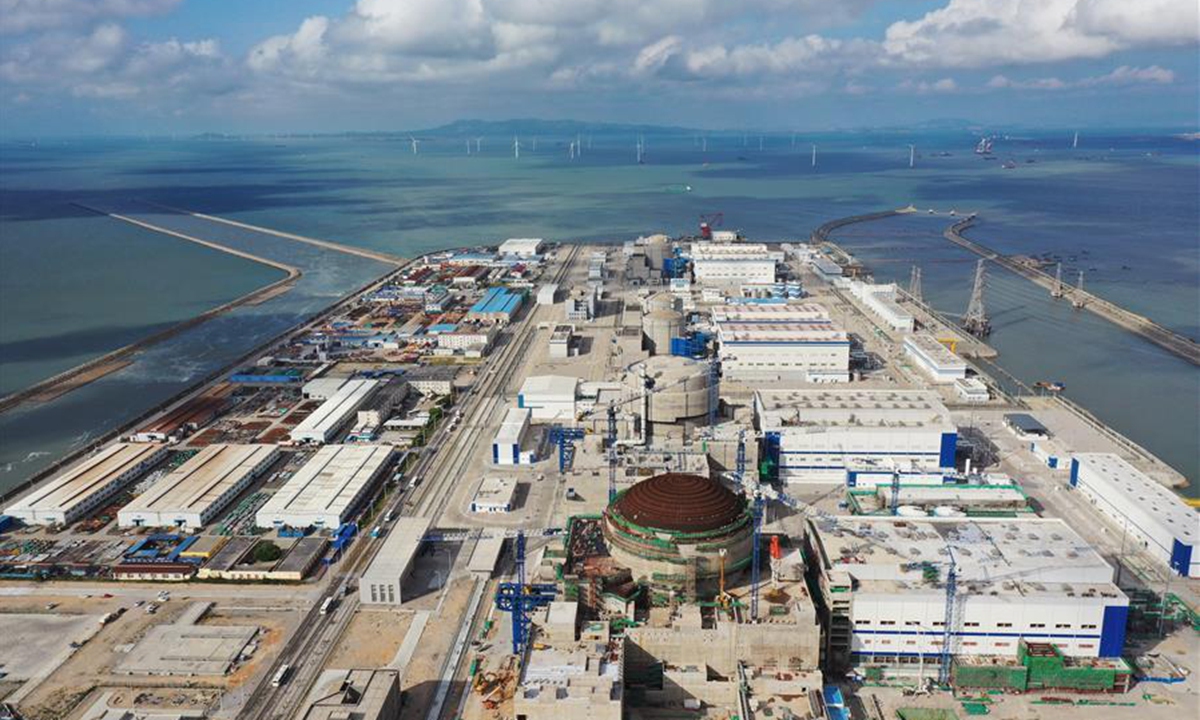
Aerial photo taken on August 31, 2020 shows a panoramic view of Fuqing project in Fuqing, East China's Fujian Province. Photo: Xinhua/Guo Donghai
China's National Development and Reform Commission (NDRC) on Tuesday issued the 14th Five-Year Plan (2021-25) for a modern energy system, in which it outlined clear targets for annual energy supply capacity while specifying measures to enhance the country's energy independence, including increasing nuclear power as the country is going greener.
The latest government plan is in line with China's long-standing commitment to carbon emissions reduction targets, while securing energy supplies amid the ongoing COVID-19 pandemic and growing global uncertainties, analysts said.
In a joint report issued by the NDRC and the National Energy Administration, explicit targets have been drawn for promoting the active development of nuclear power in a safe and orderly manner, aiming to achieve the installed capacity of nuclear power plants at about 70 million kilowatts by 2025.
The operation of nuclear power is stable and reliable, and the refueling cycle is long, which makes it suitable for the base load of the grid and necessary load tracking, Lin Boqiang, director of the China Center for Energy Economics Research at Xiamen University, told the Global Times on Tuesday.
Nuclear power can be used as a large-scale base load power source to replace fossil energy if safety can be ensured, Lin said.
On the premise of ensuring safety, the country should actively promote the construction of coastal nuclear power projects, maintain a stable construction pace, and rationally deploy new coastal nuclear power projects, according to the report. In order to achieve the target, measures such as promoting demonstration projects of advanced reactor types such as high-temperature gas-cooled reactors, fast reactors, modular small reactors and offshore floating reactors should be conducted.
The comprehensive utilization of nuclear energy in fields such as clean heating, industrial heating and seawater desalination are to be further promoted, the plan said.
After more than 30 years of continuous development, China's nuclear power has achieved a major leap in terms of technology.
In January 2021, the world's first demonstration project of China's independent third-generation nuclear power Hualong One in East China's Fujian Province was officially put into commercial operation, according to media reports.
The operation of Hualong One shows that China's nuclear power technology has entered international leading ranks, and has become one of the important ways to achieve the nation's "dual carbon" goal.
While China has maintained a high safety standard of nuclear power plant operations, nuclear energy shouldn't be broadly adopted as the major energy production source in achieving carbon neutrality, Lin said, noting that wind and solar power will still be the drivers in meeting the carbon reduction targets.
The government plan also highlighted the targets for the annual production capacity of 4.6 billion tons of standard coal, 200 million tons of crude oil, 230 billion cubic meters of natural gas, and about 3 billion kilowatts of the total installed capacity for power generation in further enhancing the nation's energy reserves and the independence of energy supply capacity.
As the country is moving toward green energy, the transformation of coal power from a primary power source to a basic guarantee and system-regulated power source that provides auxiliary services is to be accelerated, analysts said.




